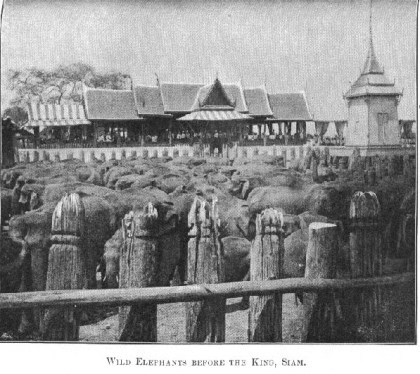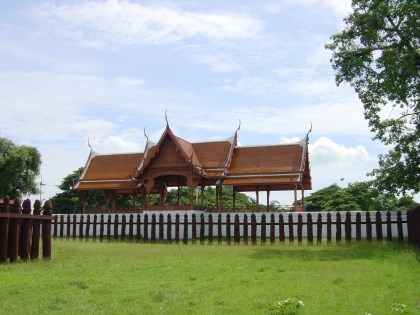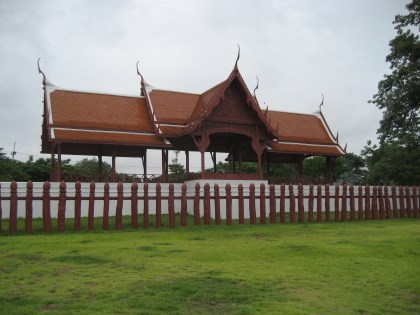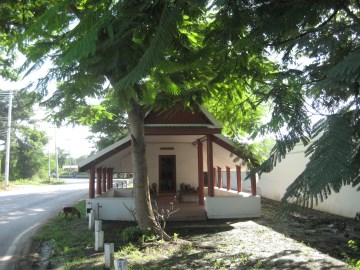| KHOCHA PRAWET MAHA PRASAT |

| Khocha Prawet Maha Prasat was one of the five palaces outside the city, mentioned in the old documents. Following the Royal Chronicles of Ayutthaya, King Narai (r. 1656-1688) ordered its construction in 1657. It consisted of a main building and a assembly hall especially reserved for the performance of all the royal ceremonies in Phaniat area (1). Here the Brahmans performed different royal rites. King Narai had a divine statue cast of 50 cm high, gilded with gold and ornamented with niello (2). The statue, decorated with a ring, was exclusively reserved for the performance of the Royal Ceremony for Elephant Works. "Now in that year of the monkey, [F: eighth of the decade,] the king ordered one statue of the Holy Divine Works to be cast, approximately a little over a sòk high. It was covered in gold and [BCDE: ornamental] [F: decorative] paraphernalia [BCDE: and decorated with a ring] of Royalty niello. During the year of the cock, ninth of the decade, the Holy Feet of the Supreme Paramount Reverence and Holy Buddhist Lord Omnipotent issued a holy royal proclamation commanding Phraya Cakri to prepare a building for the Royal Ceremony of the Register of Brahma and an assembly hall to be reserved for the performance of all the holy royal ceremonies on the prairie in the Vicinity of the Elephant Corrals." [1] In the same chronicles we read that in 1661, Chao Phraya Kosathibodhi Pan proceeded with the royal throne barge to the landing place in the vicinity of the elephant kraal to go watch and control a warfare training at Phaniat, prior to leave for Chiang Mai with an army. Pan encamped at the pavilion "which constituted the site of the royal seat". "When an auspicious moment prevailed, orders were accordingly given to beat the [CD: victory] gongs and to play the conch shell trumpets and musical instruments in a loud and resounding tumult—the victory drums [CD: booming boisterously] [F: and lamps boisterous]—to the point where the earth and waters were about to be destroyed, and to set the military procession in motion to advance by densely protective squadrons and to proceed by the water routes all the way to the landing place in the vicinity of the elephant corrals. Caophraya Kosathibòdi [CD: accordingly] disembarked from the holy throne barge and, surrounded in great profusion to the left and the right, before and behind, by [D: all] his [CD: various] thao phraya and officials in royal service, encamped at the pavilion which constituted the site of the royal seat." [2] The old palace was looted and burned down by the Burmese in 1767 at the fall of Ayutthaya. "Meanwhile, Nemiao, the general of the armies in the stockade at the Three Fig Trees [Pho Sam Ton], thereupon had the Burmese troops advance to set fire to and burn down that palace at the Elephant Corrals." [3] From the testimony of the imprisoned residents of Ayutthaya we know today that the Khocha Prawet Maha Prasat had a single mondop spire, four-level roofs with wings extending from the main building in two directions like the Jakkrawat Phachaiyon Maha Prasat (3). The Khocha Prawet palace was open, without walls and had two storeys. It was sited on a mound at the elephant enclosure for the king to watch the capture of wild elephants and elephant herds leading in wild elephants. There was a crow’s wing fence of posts behind this palace, and two large brick pavilions for royal victuallers to provide provisions. [4] Jeremias Van Vliet, a VOC merchant of the Dutch settlement, wrote in one of his works that the Kings were crowned at Phaniat (likely the Racha Bhiseka or coronation ceremony). His texts - as well as the royal chronicles - make also reference to a boat landing in the area. The landing must have been somewhere in the vicinity of the old kiln, along the old stretch of the Lopburi River called today Khlong Hua Ro. "He ordered the royal boats to be made ready and the mandarins to go by boat with him to the Phaniat (the place were the elephants are kept and the kings are crowned) in order to proclaim him king and swear oaths of allegiance to him." [5] A Brahman statue was found here at the kraal at the time Prince Thepphonphak (1785 - 1837) as Krom Phra Khochaban (director of the Royal Elephant Department), lead the restoration works at the kraal and supervised the elephant round-up in the reign of King Rama II (r. 1809 - 1824). This statue ended up in a niche of the prang of Wat Phutthai Sawan. When the King got word of it, he ordered the image moved to Bangkok. It was re-casted as an image of the Buddha wearing ornament and plated with silver; and moved to the Phra Nak Hall. King Rama IV (r. 1851 - 1868) placed the image at the Prasat Phra Thep Bidorn (the Royal Pantheon - The Shrine of the celestial Ancestors) in Wat Phra Kaeo at Bangkok. (4) [6] The royal residence was repaired in a simplified version of the original, without a mondop spire (likely indicating its loss of royal status) and only three-level roofs extending in two directions, by Rama I. It was repaired in the reign of Rama III and twice in that of King Rama V. [6] |

| (View of the Khocha Prawet Maha Prasat. Photograph likely from the end of the 19th century. The reconstructed building has a three-tiered roof and no mondop spire) |
| The palace reconstruction we see today at the elephant kraal has been again reduced in size as there are only two-level roofs extending in two directions anymore. |


| (View of the Khocha Prawet Maha Prasat today. The reconstructed building has today only a two-tiered roof) |
| Footnotes: (1) Today in Suan Phrik sub-district. (2) Niello is the process and the result of annealing (literally blackening), or fixing by fusion, on a decoratively incised polished metal (usually silver, but occasionally gold) surface, an opaque, black (non-mercurial) amalgam of silver, copper and lead. [7] (3) The Jakkrawat Phachaiyon Maha Prasat was constructed in the reign of King Prasat Thong in 1632, astride the palace’s east wall (near the southern end) at the edge of the parade ground, from which the king reviewed his troops and enjoyed martial displays. This palace though had three storeys. [8] (4) There is mystery around the finding of this image. Amatyakul sets the findings in the reign of Rama I (r. 1782 - 1809). Also an information board on the site of Wat Phutthai Sawan gives 1784 as the year of the discovery and both sources refer to Krom Luang Thepphonphak as the one who did the discovery. The problem here is that this prince was only born in 1785 and became director of the Royal Elephant Department in the reign of Rama II, thus after the death of Rama I. References: [1] The Royal Chronicles of Ayutthaya - Richard D. Cushman (2006) - page 245 / Source: Phan Canthanumat, British Museum, Reverend Phonnarat, Phra Cakkraphatdiphong & Royal Autograph - Casting an Image, and the Ceremony of the Register of Brahma. [2] The Royal Chronicles of Ayutthaya - Richard D. Cushman (2006) - page 293 / Source: British Museum, Reverend Phonnarat & Royal Autograph - War With Chiang Mai. [3] The Royal Chronicles of Ayutthaya - Richard D. Cushman (2006) - page 517 / Source: Royal Autograph - Burmese Complete Their Encirclement of Ayutthaya. [4] Chris Baker - Final Part of the Description of Ayutthaya - Journal of the Siam Society, Vol 102 (2014) - page 204. [5] Van Vliet's Siam - Chris Baker, Dhiravat Na Pombejra, Alfons Van Der Kraan & David K. Wyatt (2005) - page 228. [6] Guide to Ayudhya and Bang-Pa-In - Tri Amatyakul (1957) - page 60-1. [7] Journal of the Society of Arts (no. 2464 vol. XLVIII, page 250-2) - George Christopher Molesworth Birdwood - London: Society of Arts (9 February 1900). [8] Charnvit Kasetsiri & Michael Wright (2007) - Discovering Ayutthaya - Toyota Thailand Foundation - page 64. |
| Text & Photographs by Tricky Vandenberg - August 2014 |



| Krom Luang Thepphonphak received a commemoration shrine on the northwestern side of the Khocha Prawet Maha Prasat. The shrine is a small pavilion with a two-tiered roof situated along the road leading to Wat Borom Wong. |
| (Krom Luang Thepphonphak's shrine) |